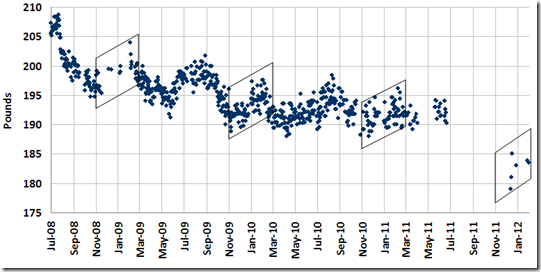Saturday, February 11, 2012
Sunday, February 5, 2012
Update on a Data Junkie’s Waistline
Several months ago I wrote about an experiment where I weighed myself every day for several years to try and better understand how my body works. I was inspired by Ted Fujita, the famous tornado researcher (when you hear about “F5 tornado”, the F is for Fujita). On his days at home he would continuously measure his weight and other things like blood pressure and mark their reaction to events e.g. mowing the lawn, eating a meal, taking a nap, and so on.
The ups and downs of my weight described in the previous post were a great analogy for the difference between weather and climate. Yesterday it was veritable t-shirt weather (61 F/16 C) in Hartford, Connecticut, US where I am now. Last year there was so much snow, it was like the movie The Shining. But what does it mean, are there any long-term trends?
I haven’t been able to keep up my routine while traveling, but I did find scales here and there to try and fill in the gaps. So here’s the latest update:
This shows 3 1/2 years of weights, from July 2008 on the left to February 2012 on the right. There’s three things to notice:
1. There is a lot of day to day “noise”. \Weight can swing five or more pounds in a day but it usually goes away quickly. This is a bit like the passage of weather systems and cold/warm fronts overhead.
2. There are slow seasonal drifts, cycles that last several months. The diagonal blocks show what happened each year between November and February. It seems typical to gain five pounds over the holidays, but then to lose it in March … And then put on more weight in June (Australia’s winter) and take it off in September. Weatherwise, this might be the difference between summer and winter or the irregular but sort of cyclical effects of El Nino.
3. In addition to the gentle trend between 2008 to 2010, there is a sharp shift in 2011 after the gap. I have been active and walking much more and eating simpler foods while travelling full-time. It has been a major change, unlike anything seen before. Could that last shift be like climate change?
What you’re also not seeing is the within-day variation of weight. If I had to guess, it is lowest before breakfast and highest after dinner and varies about two or three pounds from lowest to highest.
Could someone argue that my going from 179 to 184 in the most recent month means the shift didn’t happen or that the trend has now reversed? Probably not, considering that it is within the pattern of the usual December/January holiday-time body inflation. What is important is setting record low weights on individual days and having a low overall average over the last two months.
However, I see parallels with how some discuss the relative lack of trend in temperatures over the last 10 years. Yes, the last 10 years are very much warmer than 30-50 years ago, in some years setting records… but there’s been a levelling off. Is it a small cycle within a trend?
I will say though that if the trend from the last month goes on forever (+5 pounds per month), I’ll be ginormous next summer. Or if the trend from the last four months is extrapolated (-2 pounds per month), I’ll weigh just about 0 pounds in 8 years…
Friday, February 3, 2012
Australia Re-opens Investigation of 2011 Floods
Roger Pielke Jr has some interesting analysis of a surprise twist in the investigation of the 2011 floods in Queensland. In a nutshell, dam operators had the standard operating procedure of making high releases when the reservoir filled to a certain level. Instead, the operators were suspected of holding water in the dam, hoping (based on their in-house river forecasts) that a flood wasn’t coming. The gamble didn’t pay off- there was flooding and the dam had to make higher releases than they would have had to otherwise, making the flooding worse.
Photos of Queensland’s Flood Inquiry
The controversy comes because new and conflicting information was given to the Royal Commission of Inquiry. The Commission took earlier reports from the engineers at face value and these largely said that the dam was managed by the book. That story has changed and under examination one of the Dam engineers was left in tears on the stand today.
To me, it is a bit early to fully appreciate what is going on with a case as complex as this one. At the very least, the political election has been delayed until this issue has been resolved.
Thursday, February 2, 2012
Big Water in the Outback (Australia)
About a year after the last flood disaster, Northeast Australia is getting hit again with major rains and high water. Thousands are being evacuated, with hundreds being airlifted by helicopter.
Photo of Flooding in Grafton
Here is today's rainfall map from the Bureau of Meteorology, red areas are where there has been more than 100 mm (~4 inches) of rain in a day.
From one report about the heaviest areas of rainfall:
Croki and Manning Point have been warned to prepare to evacuate as the Manning River continues to rise. That evacuation order was likely to be put out later on Thursday, Dep Comm Pearce said. The region has been hammered with 250mm [~10 inches] of rain overnight, and the town of Wee Waa is completely isolated. About 2500 residents there will be monitored through regular food and supply drops, Dep Comm Pearce said.
I’ve never experienced 10 inches of rain in a day, it’s hard to even visualize. Not surprisingly, the rivers are also high:
Roughly, green means some inconvenience, yellow means there might be some damages and red means total chaos. Parts of the Balonne River (at Weribone) are already around 3 meters (~10 feet) deeper than the threshold for that worst category. The Mehi and Gwydir rivers continue to rise to levels not seen since the 1970s.
This all comes on the tail of recent floods:
"We are only six weeks out from the last floods so the ground is sodden," says Ms Humphries.
"All the billabongs, all the creeks, all the gullies are already full and there's nowhere for this water to go except up."
Here's what the Moree Plains Shire Mayor (Katrina Humphries) had to say about people heeding the evacuation orders:
"People have had plenty of time to prepare. Some people will want to stay behind, but they can get into difficulties, some have refused to leave and then and called for help later. It is better if everyone goes," she says. “The old timers are telling me that this flood will be as bad as the floods of 1955. We also just don't know how much water is headed our way as most of the waterways in this region are not metered. What I don't want to see is any loss of life and I hope we don't have any loss of life but it is very hard to gauge the stupid factor. You can give people advice but there are no guarantees that the stupid factor will not get in the way, driving through floodwaters, swimming in floodwaters, things like that. But if people do get in trouble after being silly and need to be rescued, they won't get much sympathy from around here."




